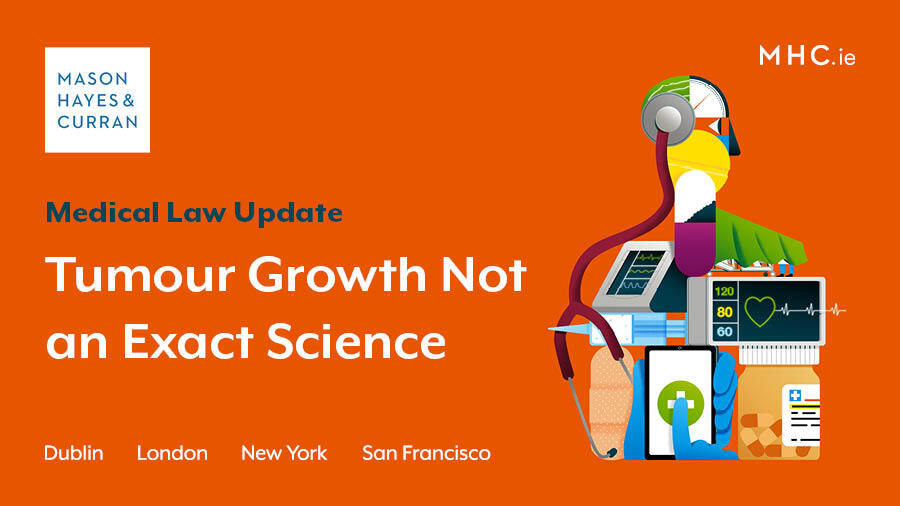Tumour Growth Not an Exact Science

The High Court decided against Catriona Crumlish, who alleged Letterkenny University Hospital (the Hospital) delayed in diagnosing her breast cancer.[1]
Ms Crumlish, the Plaintiff in this case, did not prove there was any delay in diagnosis. The Plaintiff’s argument relied heavily on an academic paper, referred to as the “Peer Paper”,[2] to estimate the size of her cancer when she first attended the Hospital with two lumps in her breast. The Court concluded that it is not reasonable to rely exclusively on an estimated “tumour doubling time” as asserted in the Peer Paper to track cancer development accurately. The Court deemed that other complex factors affecting cancer growth need to be considered and warned that the Peer Paper could be misleading in isolation.
The claim
The Plaintiff sought damages for injuries arising from an alleged failure by her treating doctors to diagnose breast cancer when she attended the Hospital in May 2017 with two lumps in her right breast. She claimed her doctors failed to carry out all of the required steps of a “triple assessment” by a surgeon, a radiologist and pathologist, which would have detected her cancer. She was examined by a surgeon and radiologist only. No sample was taken and the cyst was not aspirated with a fine needle. She was advised she had a number of cysts which might change in size but she shouldn’t worry. Breast cancer was diagnosed five months later in October 2017.
The Plaintiff needed to prove that:
- Her care fell below the standard expected of her doctors
- Her cancer was present and identifiable in May 2017, but missed
- She required further treatment than she would have if her cancer had been detected earlier
While the Court accepted the cancer was present in May 2017, the Plaintiff did not prove her cancer was detectable at that time, so the Court found there was no delay in diagnosis.
The Plaintiff’s evidence
Professor Bundred, a consultant surgeon retained as an expert witness for the Plaintiff, relied on the Peer Paper to estimate the probable size of her cancer in May 2017, based on its volume in October 2017. The Peer Paper estimates a cancerous tumour can double in size as quickly as every 44 days or as slowly as every 147 days. Professor Bundred claimed the tumour doubled in volume in 45 days, without factoring in a possible range of “tumour doubling” times. Using this calculation, the tumour would have been the exact size of the pea-sized lump which had been identified in May 2017.
The Court referred to Duffy[3],a recent judgment on the independence and impartiality of expert witnesses. The Court stated that Professor Bundred’s unjustified selection of a 45 day doubling time for this cancer, which neatly fit the May 2017 lump size, indicated that he was biased. This expert’s evidence also contradicted evidence he gave in another case, in which he said the Peer Paper could not be relied upon.[4]
The Hospital’s evidence
The Hospital fully defended this claim on the basis that:
- A cancer was present in May 2017 but it was not identifiable
- The large “pea-size” lump detected in May 2017 was a cyst, not a cancer
- It is not possible to be certain about the potential doubling time of the Plaintiff’s cancer based on average figures taken from the Peer Paper. It could have been faster or slower than 45 days and therefore would not have been the same size as the “pea-size” lump in May 2017, as claimed
Problems with the Peer Paper
This decision identified many issues with the Peer Paper:
- Crucially, this Paper excluded fast growing cancers, like that of the Plaintiff’s
- It is an outdated study on a limited number of participants with breast cancer from 1993
- It used mammograms only, which is not the most effective way of detecting a tumour
- The authors created the Paper to improve screening programmes and never purported to offer a method of measuring growth rates in individual cancers
- The Paper itself acknowledges that the growth rate curves used, exponential curves, were the wrong model to use
- Subsequent studies estimated very different tumour doubling times for breast cancer
The Court’s decision
The Court decided that the Plaintiff did not prove that the lump detected in May 2017 was a cancer based on a 45 day tumour doubling time. The Court also concluded that it was more likely that the reporting radiologist’s report of the breast imaging in May 2017 was accurate and that a 12mm cyst caused the lump. As there was no delayed diagnosis, there was no need for the Court to determine whether the Plaintiff’s care at the Hospital was negligent or not.
The Court favoured the Hospital’s evidence that the Peer Paper should not be used blindly as a simple scale for estimating tumour size, as it ignores the complexity of cancer development. Many other factors such as the Plaintiff’s age and tumour characteristics need to be considered when estimating a range of potential tumour doubling times. The Court stated it is simply not possible to be certain about the potential doubling time of a tumour based on average figures taken from the Peer Paper in isolation.
Conclusion
The key message is that estimating tumour growth is not an exact science. The Peer Paper should not be exclusively relied upon by experts to bolster the arguments of the party who retained them. Tumour doubling times can provide helpful guidance in medical negligence cases if relied upon correctly. These calculations can be a useful tool to approximately assess when a cancer developed and whether it was detectable at a certain time. Any expert evidence relying on tumour doubling times should acknowledge that cancer growth can’t be calculated definitively in every case. An expert’s role is to give independent advice to the Court rather than tailoring their opinion to fit snugly around the arguments of the party who retained them.
For expert legal advice regarding the defence of negligence claims, contact a member of our Healthcare or Medical teams.
The content of this article is provided for information purposes only and does not constitute legal or other advice.
[1] Catriona Crumlish v. HSE, High Court, Record No. 2020/553P
[2] Age-Dependent Growth Rate of Primary Cancers – Peer et all, 2003
[3] Duffy v. Brendan McGee & Anor [2022]
[4] Rossiter v. Donlon [2019] IEHC 105
Share this:


